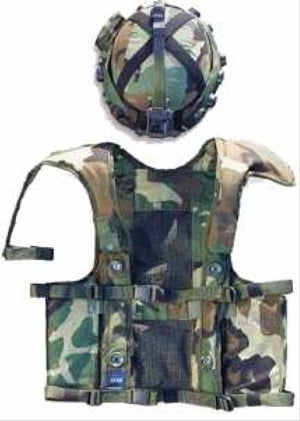The Multiple Integrated Laser Engagement System (MILES) has been in service with a number of militaries the world over, beginning in the 1980s. MILES has gone through a number of different design iterations over the years, to include making the system more compact and light weight. For those unfamiliar with the system essentially it is a training simulation Laser Tag Pro, being able to be outfitted to individual soldiers, vehicles, even aircraft. When using blanks in small arms or larger caliber weapons, the system shoots out a laser when the blank is fired. If the laser impacts the MILES gear on an opposing force, the system of that force shuts down, thus registering a “Kill”. The concept for the program is a brilliant one, but it saw a number of issues that retarded its potential. From the gear causing neck problems, to being unreliable at times, and most importantly cost. Throughout my time in the infantry, I never once utilized or even saw MILES gear in use at all.
A replacement system for MILES that initially came out in 2006 is the Deployable Instrumentation System Europe (DISE). Interestingly this system is very specifically used and designed with forces within EUCOM, and not the United States. To be precise, it is the Seventh Army Joint Multinational Training Command. This probably has to do with the various budgets available to EUCOM that the U.S. Army Training Command doesn’t have or want access to. Although DISE has been in use since 2006, as of 2015 PEO issued out a solicitation to upgrade the program. Right now Saab Technology has the contract to produce the device.
The largest difference between MILES and DISE is that DISE is GPS connected, allowing commanders to view hits in real time on a computer screen, or afterward during an after-action review of a training operation. In addition, the components are much smaller and more light-weight than MILES was at the time of adoption. With MILES gear apparently crafty Lance Corporals and Specialists were known to have reset their device if they were “killed”, thus respawning. DISE has solved that feature through the technology utilized.
One of the other upgrades is that the system has an audio box on it that emits sounds of bullets passing by a soldier if the opposing force is shooting within the proximity of it. Go to 2:15 in this video to hear the sounds-
From the solicitation-
DISE is a Soldier, vehicle and building GPS and radio tracking system that combined with an exercise control (EXCON) cell can be located with the supported unit within the training area. The EXCON records all actions, events and engagements. The recording of data creates an immediate multimedia After Action Review (AAR) playback product to allow Commander’s, Observer Controller /Trainer’s and Soldiers to see exactly what occurred during a training. The DISE systems located at Grafenwoehr has been supplemented with similar Deployable Instrumentation Systems (DITS) from Ft Campbell, Kentucky.
The Seventh Army Joint Multinational Training Command requires upgrading DISE and DITS Personnel Detection Devices (PDDs) and the Small Arms Transmitters (SATs). The DISE and DITS PDD upgrade requires a new processor board that enables WLN frequency setting for 868MHz and 915MHz and dual laser coded templates for a MILES and OSAG2 capability. Upgrade of the DITS and DISE SATs require a new optic module to enable the SATs to operate with MILES and OSAG2 specifications. Upgrading these systems to OSAG2 will make the system interoperable with other NATO Partners.A total of 1549 Personnel Detection Device (PDD), 1743 Small Arms Transmitters (SAT), 433 Small Arms Alignment Device (SAAD) and 39 Controller Guns require upgrade. This upgrade will support the USAREUR Commanders’ Connected Training initiative and the U.S. European Reassurance Initiative (ERI). This converted equipment will allow for greater integration, creating the capacity for a Brigade sized U.S. and Coalition Forces to train simultaneously at multiple deployed locations.
 Your Privacy Choices
Your Privacy Choices
